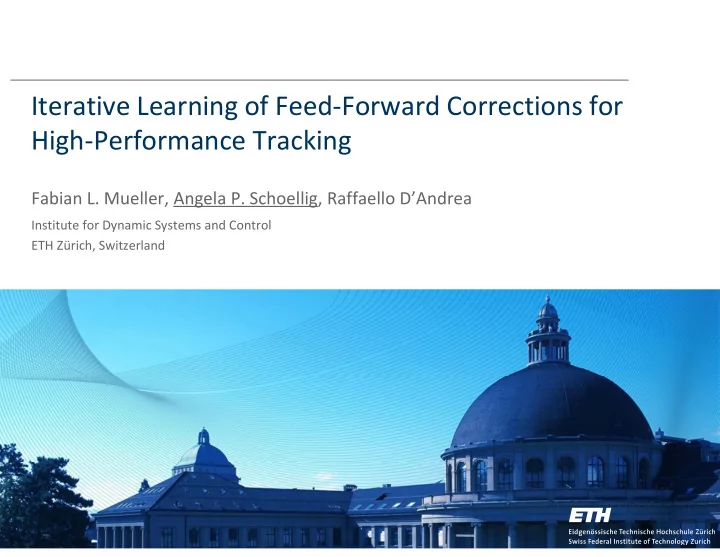

Iterative Learning of Feed ‐ Forward Corrections for High ‐ Performance Tracking Fabian L. Mueller, Angela P. Schoellig, Raffaello D’Andrea Institute for Dynamic Systems and Control ETH Zürich, Switzerland 1
Iterative Learning of Feed ‐ Forward Corrections for High ‐ Performance Tracking Fabian L. Mueller, Angela P. Schoellig, Raffaello D’Andrea Institute for Dynamic Systems and Control ETH Zürich, Switzerland 2
GOAL – Precise tracking of a desired output trajectory Angela Schoellig 3
GOAL – Precise tracking of a desired output trajectory Example: Quadrotor vehicle Angela Schoellig 4
GOAL – Precise tracking of a desired output trajectory Example: Quadrotor vehicle Typical setup: Feedback control Measured Desired position position CONTROL Large repetitive error Limitations of feedback control: Disturbances and unmodelled dynamics (non ‐ zero mean) Angela Schoellig 5
LEARNING APPROACH Improve the performance over causal, feedback control by learning from a repeated operation. Disturbance Input Output SYSTEM LEARNING Potential: Acausal action, anticipating repetitive disturbances. Angela Schoellig 6
LEARNING APPROACH Input Output SYSTEM DISTURBANCE ESTIMATION INPUT UPDATE Updated Estimated input disturbance 1. Dynamics model (here: from numerical simulation) 2. Disturbance estimation* 3. Update of input trajectory* * Angela P. Schoellig, Fabian L. Mueller, Raffaello D‘Andrea, “Optimization ‐ based iterative learning for precise quadrocopter trajectory tracking,” Autonomous Robots, 2012 7
1 | DYNAMICS MODEL Output sequence, constrained sequence Input sequence SYSTEM Prerequisites: Coarse model • Desired output trajectory • with corresponding nominal input Angela Schoellig 8
1 | DYNAMICS MODEL Define: Linear mapping from input deviations to changes in output and • constrained variables : From numerical dynamics simulation: Obtain by running identification runs • • Apply • Obtain ith column Angela Schoellig 9
1 | ITERATION ‐ DOMAIN MODEL For each trial Recurring disturbance . Unknown. Only small changes between iterations: trial ‐ uncorrelated, zero ‐ mean Gaussian noise Noise . Unknown. Changing from iteration to iteration. From trial to trial our knowledge about improves. 10
ESTIMATION EXECUTE UPDATE OF DISTURBANCE ESTIMATE via Kalman filter in the iteration domain: ESTIMATE Prediction step: UPDATE Measurement update step: Obtain . 11
INPUT UPDATE INPUT UPDATE via convex optimization: EXECUTE minimizes the expected tracking error in the next trial: ESTIMATE UPDATE subject to Obtain . 12
EXPERIMENTAL RESULTS Measured Desired position position CONTROL Angela Schoellig 13
VIDEO: https://youtu.be/zHTCsSkmADo?list=PLC12E387419CEAFF2 14
CONCLUSIONS Learning algorithm • combines model data with experimental data Convergence in around • 5 ‐ 10 iterations Repetitive error components can be effectively compensated for by learning from past data. Result is an improved tracking performance . 15
Recommend
More recommend